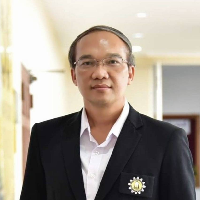Preprint
Article
Guidelines for the Waste Management Development Leading to Mahasarakham University Becoming a Green University
Altmetrics
Downloads
115
Views
78
Comments
0
A peer-reviewed article of this preprint also exists.
This version is not peer-reviewed
Submitted:
29 February 2024
Posted:
29 February 2024
You are already at the latest version
Alerts
Abstract
Continuity of activities and projects are important for sustainably developing organizations, especially universities. The purpose of this research study is to find university development guidelines regarding waste management according to the green university ranking criteria for sustainable developments by studying and collecting the data covering the last five years (2019 - 2023) of Mahasarakham University. We also analyzed and synthesized lessons learned from the details of the operations and the factors involved in successes while comparing and providing suggestions for the operations in the next year. It was found that waste management that resulted in continuous developments that achieved the goals of Mahasarakham University consisted of the five guidelines. (1) Making green university policies and using them as the (key performance index) KPI of the divisions and also announcing the university's waste management policies by applying the principles of 3R (Reuse-Reduce-Recycle). (2) Allocating the budgets supporting the projects' activities according to the evaluation criteria. (3) Student and personnel participation as well as the mechanisms used by the committees from various administrative divisions such as Student Council, Student Association and clubs to drive the operations. (4) Identifying the main responsible individuals and committees for the green university who communicated and drove the operations while collecting, analyzing and preparing the data. (5) Follow-ups and evaluations of the project's activities with the Plan-Do-Check-Act (PDCA) processes for continuous and sustainable developments and improvements leading to the green university. With the above operations, Mahasarakham University's waste management scores of the six indices during 2019 - 3023 increased annually as follows: 900, 900, 1050, 1275 and 1350.
Keywords:
Subject: Environmental and Earth Sciences - Waste Management and Disposal
1. Significance and Background
Globally sustainable development was implemented in 2015 in order to meet the current and future demands of humans as the Global Development Agenda for the next 15 years (2016 - 2030) based on the economic sustainability [1]. The Global Development Agenda considered management, job creation and support for tourists, the social sustainability that considered infrastructure development and local cultural conservation. It also addressed environmental sustainability considering the effects of human’s actions resulting in wastes that were environmental pollution [2,3]. In 2017, Thailand set sustainable development goals of the 20 Year National Strategies and made the 12th National Economic and Social Development Plan for preparing and creating the foundations for improving the country into a developed, secure, prosperous and sustainable country. The philosophy of sufficiency economy [4] was employed as the main principle for the national and organizational developments in 2021 in order to improve educational institutes and universities according to the sustainable development guidelines. Mahasarakham University made Mahasarakham University’s Education Plan No. 13 (B.E. 2017 – 2026) for organizational management in order to become a smart university. One of the sustainable development goals is the green university development by improving the safety, appearances and environmentally friendly properties of the university’s areas as well as facilitating education, creation, research studies, innovation and academic services [5] as important parts of the improvements of the university according to the sustainable developments [6,7].
This is for measuring the university’s efforts towards the sustainability. The green university ranking was started in 2010 by the University of Indonesia. It was then known as the UI Green Metric that focuses on three foundations which are social foundation, economic foundation and environmental foundation, in order to achieve balances [8,9,10]. Socially, people involvement and life quality improvements are emphasized. Economically, the people’s mutual benefits are focused in the long term. Environmentally, resource efficiency is valued by mainly considering environmental effects [11,12]. This is a mechanism supporting the university to maintain the widely accepted environments. To measure the university’s efforts to achieve sufficiency, online surveys were conducted in order to present the university’s projects and policies about the sustainability according to the frameworks about environments, cost efficiency and fairness [13,14,15]. The survey used six criteria with a total score was 10,000. These included Setting and Infrastructure (SI), Energy and Climate Chang (EC), Waste management (WS), Water Usage (WR), Transportation (TR) and Education (ED)(University of Indonesia, UI Green Metric World University Ranking) [16,17,18].
Mahasarakham University focuses on environmentally friendly management and sustainable development to become a green university and to create environments facilitating education as well as being safe and environmentally friendly in the community [19,20,21,22,23]. Activities of students and other personnel produced many wastes [24,25,26]. These were considered as an indicator of the evaluation criteria for management and sustainable environments by reusing the wastes, treating the organic wastes, treating the inorganic wastes, treating the wastewater and implementing the paper and plastic reduction policies in the campus [27,28]. As a result, the goals were achieved and the scores were increased continuously [29]. However, issues and suggestions arose each year that must be considered for planning and continuous improvement of developments [30]. There were additional details of the evaluation. These demonstrated the developments clearly. Mahasarakham University treated the wastes according to the indicators. If analyses and syntheses are conducted; planning the budget management guidelines, activities or projects will be affected and truly consistent with the evaluation criteria [31,32,33].
Therefore, this study included data about the waste management (WS) for the last five years or from 2019 to 2023. Details of the evaluation criteria were studied. Years with increased scores were used to identify the factors of the successes of the green universities regarding the waste management leading to the sustainable development and to obtain the suggestions for the operations in the next year.
2. Methodology
2.1. Research Areas
This research study was conducted in two areas inside Mahasarakham University: the Kham Riang Campus, Sub-District Kham Riang, Kantharawichai District, Mahasarakham Province and the City Campus in Mueang District, Mahasarakham Province as shown in Figure 1 and Figure 2. it can be seen from the figures that both areas of Mahasarakham University are about seven kilometers from each other. The first area is in an urban area covering about 0.58 square kilometers. It is where four faculties are situated. - Faculty of Medicine, Faculty of Veterinary Medicine, Faculty of Tourism and Hospitality and the Faculty of Education. There is also Sutthawet Hospital under the Faculty of Medicine. Kham Riang Area covers about 2.08 square meters (Km2). It is where the President’s Office and over 16 faculties/units are situated.
2.2. The Green University Ranking Criteria Regarding Waste Management
The full score for the six aspects of the UI Green Metric World University Ranking was 10,000 (University of Indonesia, UI Green Metric World University Ranking). The score was used as a criterion for evaluating the university’s development. However, this study used it only for consideration of waste management. The waste management evaluation criteria consisted of six indicators. Each indicator had a maximum score = 300. So, the total maximum score was 1,800. The weight was 18% of All evaluation criteria were weighted at 18%. The details are presented in Table 1. This study commenced by studying the details according to the criteria of each indicator in the last five years (2019 - 2023) and using these for analyzing and planning efficient operations as well as continuous improvements.
2.3. The Waste Management Operations
Mahasarakham University’s waste management operations covered principles for making plans, practices, follow-ups and improvements by using the Plan-Do-Check-Act (PDCA) processes [34] as the guidelines for the operations in order to continuously and sustainably develop the university. The details of each process were as follows.
2.3.1. Plan
To develop the university into the green university, Mahasarakham University clearly set strategies leading to practices according to the goals of progressive strategies for developing the university into a green university and for conserving environments. These are goals for sustainable development and were KPIs of the organization [31] and steered the operations of the green university committees by providing clearly assigned responsibilities. Waste management committees were also appointed in the university in order represent the departments according to the concepts of involvement, clubs supporting students’ activities and budget allocations for the organization, students and personal conducting the project’s activities according to the evaluation. There were the meetings of the committees and stakeholders in order to plan the operations while driving the project towards achieving the objectives. The amount of each type of produced wastes was analyzed in order to plan the project and waste management guidelines in the following aspects.
- A recycling program for the university's wastes (WS1): the types of reusable wastes were surveyed, and suitable containers were prepared with clearly visible signs.
- A program to reduce the use of papers and plastics in the campuses (WS2): the activities using paper and plastic were analyzed in order to conduct activities and use management systems.
- Organic waste management (WS3): the sources of organic wastes were surveyed, and suitable containers were provided with appropriate signage during the preparation of areas and management.
- Inorganic waste treatment (WS4): disposal or collection points appropriate for actual amounts were prepared as well as appropriate routes and times being identified.
- Toxic waste management (WS5): the sources of toxic wastes were analyzed; practical guidelines were prepared among the organizations in order to manage and provide containers for separating other types of wastes and clear signage because these contain possibly hazardous toxins. Collection and treatment schedules were set.
- Sewage disposal (WS6): the sources of wastewater were surveyed, and the treatment systems were designed in order to treat the wastewater. Committees’ meetings were held every month in order to follow the progress of operations according to the indicators.
2.3.2. Do
The university complies with the UI Green Metric criteria for ranking green universities regarding waste management by conducting activities and projects according to the standard evaluation criteria of efficient resource management and waste management using six indicators. The operations complied with the operational plans in order to become the green university and included the followings.
A recycling program for the university's wastes (WS1) refers to recyclable wastes such as water bottles, plastic glasses, aluminum cans, paper boxes and white papers. The students and personnel were encouraged to conduct activities or projects that separated the recyclable wastes in order to add values or benefits to the wastes. Budgets were allocated for supporting the project's activities and public relations through channels such as Facebook, Line, pages, LED screens, posters and brochures in order to develop perceptions and awareness for preparing and placing bins for separating the recyclable wastes in various locations. Adding value to or using the wastes was encouraged while recording statistical data for summarizing the results of the project.
- 1.
- A program to reduce the use of paper and plastics in the campuses (WS2): the policies about paper and plastic reductions were made and announced to all departments in the university to follow. Technologies were also used for documentation management in order to reduce the amount of paper and paper was also used efficiently. Students and personnel were encouraged to use reusable products instead of one-time products while conducting the activities and projects in order to reduce wastes.
- 7.
- Organic waste treatment (WS3) refers to decomposable wastes such as foods and garden wastes. This type of waste can be used for conducting the managerial activities or projects for treating the organic wastes by providing containers for separations and collections for the purpose of management in order to reduce the wastes at the sources.
- 8.
- Inorganic waste treatment (WS4) refers to undecomposable wastes such as soft plastics, hard plastics, electronic wastes and construction materials that must be appropriately managed, used, collected at collection points, discarded according to schedules and treated correctly.
- 9.
- Toxic waste management (WS5) refers to management of wastes with hazardous components or residues that may be toxic or dangerous for lives, properties or environments and that must be managed appropriately. These are classified into three sections. - 1) laboratory hazardous wastes, 2) office hazardous wastes such as bulbs, batteries, batteries and electronic wastes, and 3) hospital hazardous wastes referring to wastes contaminated by pathogenic secretions such as blooded syringes, scalpels, gauzes or cotton wools. Appropriate containers must be provided. Places for separating the other types of wastes must be prepared. The wastes must be treated correctly.
- 10.
- Sewage disposal (WS6) refers to the disposal of wastewater from activities. To handle the wastes, the university created a treatment system, collected and treated the wastewater, and checked the quality of the treated water before it was released into the environment or used otherwise. The quality of each type of the wastes was identified and it’s the components analyzed providing representative values for calculating the total quantity of the wastes compared to the ratio of the management according to the specified criteria.
2.3.3. Check
In this study, the data for the last five years (2019 - 2023) were collected and used to analyze the statistical and qualitative data of the operations leading to the green university development regarding waste management by evaluating the following six indicators.
The recycling program for the university's wastes (WS1): the ratio of the activities or projects about recycling in the university or involvements
- The program to reduce the use of paper and plastics in the campuses (WS2): the university had clear and comprehensive policies that provided guidelines for departments. The systems were used for managing the operations efficiently, conveniently and quickly while saving energy.
- Organic waste management focused on utilizing organic wastes as much as possible during the development leading to energies.
- The inorganic waste management should focus on the upstream management instead of the downstream management. The inorganic wastes must be utilized and promoted by developing them into fuels or other products in order to encourage inorganic waste management. Nevertheless, everything should be based on the available resources. Application of management technologies should consider the worthiness of the operations performed.
- Toxic waste management should consider all hazardous wastes in the university without only the downstream treatments. The important principles of the green university emphasized internal management that utilized the hazardous wastes in order to reduce their quantity.
- There was a wastewater treatment system for managing the wastewater during sewage disposal. Devices were installed in order to improve the efficiency of the wastewater treatment. Importantly, the treated wastewater should be rotated in order to use and maximize the benefits from the resources. Nonetheless, the wastewater management must be completed within the university without being confined to specific areas because all areas must be treated and managed efficiently and safely for the students, personnel and environments.
2.3.4. Act
Improvements were made possible after studying and analyzing the activities and projects’ data affecting the waste management development during the last five years (2019 – 2023). Committee meetings generated suggestions for improving the operations in the next year. By studying the data in the last five years; the follow-ups and evaluations of the activities and projects according to the policies of each indicator showed the changes and waste management development inside the university by conducting various activities according to each indicator and covering all areas of the university with the involvements of the students and personnel of the university make the projects successful. Instead of prioritizing upstream waste management, attention was refocused instead on the downstream waste management. As a result, the development score was increased. In the aspects with the scores that were not changed, there was room for improvements by planning the budgets for conducting the activities and projects according to the indicators employed in successful waste management guidelines of universities or other organizations. This enabled linking projects in order to have better development guidelines for the next year. However, the green university ranking criteria were adjusted and had more details. The evaluation criteria and operations must study, and the Plan-Do-Check-Act processes must be replied on for checking and making plans, setting clear goals and following results in order to have continuous improvements.
2.4. Data Preparation and Input
2.3.1. Data Preparation
The data were collected, analyzed, synthesized and prepared in the forms of graphs and tables as the main evaluation guidelines. The data showed the results of the activities and projects that collected the data for 12 months in the last year. Data was gathered from all departments in the university in order to quantitatively analyze the data with a statistical software package (Microsoft Excel), using mean and percentage for analyzing the data, Microsoft Word, in order to prepare descriptive data according to the UI Green Metric World University Ranking (University of Indonesia, UI Green Metric World University Ranking)'s form for considering and showing the credit abilities of the operations for following considerations.
2.3.2. Inputs
The data were prepared according to the UI Green Metric World University Ranking's form and categorized according to each indicator. The files were recorded in the PDF format. The data were inputted into the system by October of every year. The data were inputted into the system one week before the system was closed in order to have time to verify or amend the data. If the system was closed, documents could not be amended or added.
3. Results
3.1. Results with Indicators
Mahasarakham University continuously operates and makes improvements leading to a sustainable green university according to the indicators of the UI Green Metric World University Ranking criteria. One of the indicators used was waste management, which must be appropriate, focus on sustainably environmental management, facilitate education, be safe and be environmentally friendly. The operations of a green university must involve cooperation across all sectors, set clear policies and allocate budgets for developments and improvements. The waste management inside the university must be considered by focusing on the upstream management starting from the separation process. Collection and management apply the principles of 3R (Reuse-Reduce-Recycle) which emphasizes reducing and utilizing wastes. By collecting the data in the last five years (2019 - 2023), following and evaluating the results of the activities and projects in each year reflected the changes and successes of the waste management. These show continuous developments recorded via the six indicators. The indicator scores are shown in Figure 3. in which it can be seen that the full score was 1800. Mahasarakham University's score was 900 during 2019 - 2020, and it gradually increased to 1350 in 2023. However, the score was not the full score or 1800. It needed 450 scores. The details of the results of each indicator are presented below.
3.1.1. The Recycling Program for the University's Wastes
The university supported and encouraged the students and personnel to separate and add value to or utilize recyclable wastes. Initially, waste separation bins were provided and distributed in order to generate income. Then, the students were encouraged to separate the recyclable wastes by having a recycling package contest. However, the contest was only a short time project. To promote the long-term recyclable waste separation, the university developed other projects. - a recycling bank and facility to exchange recyclable wastes with eggs. Nonetheless, the mentioned project was seemingly successful. There were the problems about the limitations of the university’s regulations which caused many to withdrawal resulting in delays. Consequently, the number of participants was decreased after which the projects were cancelled. However, the university tried to adjust the activities in order to encourage students and personnel to participate in operations and to achieve sustainability by conducting voluntary point collection activity with recyclable wastes under the green dormitory project by the students’ clubs. Voluntary point collection motivated the students to participate in the separation in order to collect voluntary points being issued according to the university’s criteria such as the Student Loan Fund (SLF) and fund selection. The point collection criteria were set clearly. As a result, the students were very interested in it. The waste recycling project was improved by conducting the innovation activity from the recyclable wastes for adding values to the wastes., The mentioned project was clearly conducted only in the students’ dormitories. To create the network for conducting the project and generalize the results to the faculties and departments in the university, there was cooperation with the private sector in order to actually enter the recycling processes. The Green University Leaves a Turn for the World to Remember with GC YOU Turn was conducted through the students’ organizations and clubs. Conducting the mentioned project clearly showed the students’ participations. The project has been conducted continuously. The results of the waste recycling project in the university are presented in Table 2.
According to Table 2, the score was increased because of the projects reflecting the number of the projects not affecting the evaluations. However, the changes of the form of the projects to covering more areas and the increased participation of the students and personnel increased the amounts of the recycled and managed wastes in the projects. As a result, the evaluation results were improved. The amounts of waste affected the evaluation criteria. The activities with the most serious effects on the evaluations should be considered in order to continue the operations according to the evaluation criteria and improve the operations. Nonetheless, this indicator could be improved by studying the details of the amended evaluation criteria in more detail and with support for budgets covering the whole university in order to continue and sustain the operations and reviewing the projects’ results with the most serious effects on the evaluations in order to generalize the results to cover and comply with the evaluation frameworks according to the factors of the successes of the green universities of Issaree Rodthatsana (2015). Some factors of the successes from the integrations of the environmental projects and activities according to the missions of each university in each aspect must involve education, research, academic services, students’ developments, students’ and internal personnel’s participations and areas surrounding educational institutes.
3.1.2. The Program to Reduce the Use of Papers and Plastics in the Campuses
To reduce papers and plastics, the university encouraged the students and personnel to use their own cups by cooperating with the shop owners joining the project. If they brought their own cups, they would receive discounts. They were also encouraged to use fabric bags in order to reduce use of plastic bags. Initially, there were only two activities in order to comply with the evaluation criteria as consistently as possible. The university implemented and announced the paper and plastic reduction policies for all departments by encouraging them to use reusable products instead of one time products. Fabric bags replacing plastic bags and refillable cups were promoted continuously. Then, technologies were used as well as documentation management system, electronic document delivery system, online repair appointment system, online document submission system and other systems were developed. Wise use of paper was also promoted by using both sides of each paper. This showed wise use of resources during the activities or projects. Meetings and seminars in the university had implemented waste minimization policies for foods and drinks. For example, foods in pots or trays were ordered. Lunch boxes were ordered in order to reduce wastes. A plastic bag reduction project was also conducted.
Table 3.
The Results of the Projects.
| Year | Score | Project results | Project details |
|---|---|---|---|
| 2019 | 150 | Total 3 Projects | 1. Ecolife program 2. Say no plastic program 3. Order refills for food and beverages 4. Electronic Document System 5. Eservices system 6. Online document submission system 7. Two-sided paper policy 8. Use environmentally friendly products. 9. Project to reduce receiving, reduce giving, reduce use of plastic bags (MSU No Plastic) 10. Say no to plastic bag project 11. Green Meeting |
| 2020 | 150 | Total 3 Projects | |
| 2022 | 225 | Total 5 Projects | |
| 2022 | 300 | Total 8 Projects | |
| 2023 | 300 | Total 11 Projects |
According to Figure 4, the scores were increased throughout the study period, and had the full score according to the UI Green Metric World University Ranking criteria because the number of the project’s increased. As a result, the indicators score was the highest score. To continue some projects, they must be conducted continuously according to the evaluation criteria and affect the university's developments, especially using the management technologies for the purpose of facilitation and efficiency as well as to reduce wasted resources. However, some projects might be halted if the number of the projects met the criteria; this was in order to use the budgets for managing and developing other things. Nevertheless, the other universities' guidelines for conducting projects were also studied and applied to continuously develop the university and to improve the management systems since the number of competitors was increasing. Some projects such as the waste management, the waste reduction in the university and the No single Use Plastic project could be conducted immediately without budgets. The plastic reduction frameworks were as follows: 1) reject the plastic bags from shops, 2) use food carrier and fabric bags, 3) carry cups or mugs, 4) reuse plastic bags, and 5) ask the shop owners to change the traditional one-time notes to the coated notes from Kasetsart University, which was nationally ranked the 2nd university regarding waste management in 2022 (UI Green Metric World University Rankings, 2022).
3.1.3. Organic Waste Treatment
The university separated and managed the organic wastes from gardens, grasses and leaves in order to gain benefits by fermenting fertilizers. The sources were managed by fermenting the fertilizers. Organic wastes were also used to improve the soil qualities and growth of ornamental plants in the university in order to reduce chemicals and residues in environments. These only emphasized on the organic waste management from the gardens. Then, the university surveyed the sources of the organic wastes. Some of the organic wastes were daily produced from the canteen and contained high amounts of food scraps being. The wastes must be managed appropriately. The university conducted a earthworm fermented fertilizer project in order to treat the food scraps produced from the canteen. The project could reduce the amounts of the wastes requiring disposal, and the products were used for nourishing the ornamental plants and also generated incomes for the university. Not only the canteen, but each faculty also had the wastes from internal activities. The Public Duties Certification (PDC) committees set these a KPI. It was an indicator that required waste management and all operations were required to reduce and separate the wastes at source. Environmental conservation bins were installed in order to treat the produced food scraps. Organic waste management was also a source of learning management and utilizing wastes for the students, personnel and external organizations. The results of the organic waste management projects are summarized in Table 4.
According to the table of the summary of the results of the organic waste management projects, the scores were obviously higher because the organic waste management projects were conducted. However, the number of the projects did not affect the evaluation. The projects were still necessary for continuing the organic waste management at the sources, the reduction of waste for disposal and the management budget reduction for improvements. Moreover, this indicator could be improved. The guidelines were studied, and budgets were provided in order to make plans and adjust the projects according to the evaluation criteria energizing sustainable management. The conversion of the wastes into energy was considered in order to obtain guidelines for completely managing all of the organic wastes in the university according to the guidelines of Mahidol University and Kasetsart University (which were nationally ranked the 2nd university in 2022 regarding waste management. Producing fertilizers and biogas were other ways to effectively manage food scraps. These activities were concrete and appropriate guidelines and forms for improving the projects in the next year.
3.1.4. Inorganic Waste Treatment
By analyzing the components of the wastes in the university, it was found that the amount of the organic wastes was the highest compared to all other types of wastes, especially soft and stretched plastic wastes (plastic bags). The university also had many restaurants, and the number of the students was increased during the study period. The university handled these situations by providing containers, black bags or waste bags collecting the wastes, bags being tied and placed at the collection points before being collected to help order and enhance convenience of the waste collection. The university provided waste collection points with doors for preventing dogs tearing the bags and violating the order. The waste disposal schedules were set clearly in order to collect the wastes before the designated times for collecting the wastes by the university. The university used the two compactor garbage trucks for collecting and transporting the wastes with local organizations burying the wastes every day in order to reduce remaining wastes, flies and bad smells. The wastes were disposed of by local organizations who were given monthly payments. It was not only the plastic management, but the hard plastics, especially containers that had contained chemicals from the laboratories, which were included in order to reduce the number of purchased or degraded containers. The waste collection routes and points are shown in Figure 5 in which it can be seen that the garbage trucks started from the parking area of the university to the 1st point near the waste separation station (the waste disposal point from Talad Noi Market's canteen to the students' dormitories), the parking area of the Faculty of Sciences, the area behind the Faculty of Arts and Culture, the 2nd personnel condo, the 3rd personnel condo, the area behind the President's Office, the Secondary Education Department of the Demonstration School and the ambulance parking area. After collecting the wastes at all points, they were sent to the waste disposal station (the waste disposal site of Mueang Mahasarakham Municipality) that was 35 kilometers away from Mahasarakham University.
The university tried to manage all produced organic wastes with the correct disposal treatment. For this, downstream waste management and only soft plastic management was focused without stating organic waste reduction methods or utilizations, the evaluation results were not changed. The university not only managed soft plastics but also focused on managing the other types of inorganic wastes by utilizing hard plastics. As a result, the evaluation results were improved as a consequence of developing and complying with the evaluation criteria as much as possible as possible. It was also the waste management guideline in the university. The guidelines of Suranaree University should be studied since they affected the national waste management ranking for two consecutive years or 2022 - 2023 regarding the complete waste management. At Suranaree University a Biomass Excellency Center was established. Plastic wastes were processed into fuels and there were mechanical and biological treatment systems, RDF production and other approaches in order to obtain the guidelines for developments.
3.1.5. Toxic Waste Treatment
The university was dedicated to managing the toxic wastes for the safety of the students and personnel. The wastes were collected and disposed correctly by sending the wastes to the private company that was legally registered each year. The details of the toxic wastes and management guidelines are shown in Table 5. In the table, toxic wastes are classified into three types according to the sources including the toxic wastes from the laboratories, the toxic wastes from the buildings and the toxic wastes from the hospital.
The university, had no operational policy reusing the toxic wastes. Although it treated all of the produced toxic wastes according to the academic principles, the evaluation results were not changed. These reflected the toxic waste management processes starting from the sources to the final treatment. To comply with the evaluation criteria, the upstream toxic waste management and reduction were valued. Moreover, the guidelines for reusing the toxic wastes were considered. Managing the electronic wastes that were considered as a type of toxic wastes that must be treated correctly were also emphasized.
3.1.6. Inorganic Waste Treatment
The university made plans and guidelines for reusing wastewater by treating it inside the buildings and that released from the buildings. The wastewater inside the buildings was treated by collecting and transferring it to an air blowing treatment system (Aerated Lagoon, AL) as shown in Figure 6 and Figure 7 by adding oxygen into the wastewater treatment system. The air blowers were installed in order to improve the treatment efficiency. The wastewater quality was also checked before and after the treatments before circulating and using the treated water by connecting the system to the watering system with sprinklers and was then used for washing the roads. Wastewater collection pipes often became clogged, with fats, especially in the canteen. Consequently, the wastewater overflowed, and bad smells were released. To solve these problems, a budget was allocated for installing grease trap tanks in order to support the treatments before transferring the wastewater to the treatment system. The wastewater management in the university reflected the changes and guidelines for solving or managing the problems according to the evaluation criteria. As a result, the scores increased obviously. The wastewater treatments should cover all areas in the university and be focused in order to utilize the treated water in order to increase the score of this indicator. Tools can also be installed in order to improve the treatment efficiency and circulate the treated water safely without affecting the environments.
According to Figure 7, Mahasarakham University designed and built the wastewater treatment system for the initial treatment of wastewater produced from all parts of the university. Coarse sieves were installed in order to filter wastes and scraps out of the pipes. For the wastewater from the canteen that usually contained fats and caused clogs, grease trap tanks were installed in order to initially treat the wastewater so as to reduce residues and transfer the water to the wastewater treatment system for treatment before reuse or releasing the treated water to water sources. To ensure that the circulation quality was good, the wastewater quality was checked according to the standard criteria.
3.1.7. The Results of the Waste Component Analysis
Waste components of the faculties and departments of Mahasarakham University. were surveyed and analyzed . The waste components were studied from Monday - Friday or five days in order to calculate the averages of the waste components. The amount and type of each waste was compared with management plans using the appropriate evaluation criteria. The details are shown in Table 6 and Figure 8.
According to Figure 8; the amount of the wastes in 2019 was highest probably because the number of the students was highest. Consequently; the amount of the waste was increased. The amount of the waste decreased in 202; presumably because the numbers of personnel and students were low due to the Covid-19 pandemic. To slow down the pandemic; the university used the work from home practice and online learning. As a result; the amount of the waste was decreased.
Figure 9 shows the results from studying and collecting the data about the amounts of waste from all departments in the Mahasarakham University. The amount of each type of the wastes produced daily is shown. The type of the waste that had the highest amount was the inorganic wastes followed by the organic wastes, recycled wastes and toxic wastes. The amount of each type of waste affected planning and managing the budgets in line with to the evaluation policies and criteria (Division of Buildings and Accommodation, Mahasarakham University).
3.2. The Results of the Operations under PDCA
To achieve success in becoming a green university according the waste management indicators, the university set clear policies and allocated budgets for operations according to the indicators. It also followed, checked and evaluated the activities and projects according to the evaluation criteria. As a result, the overall rank was obviously higher, especially for the program to reduce the uses of papers and plastics in the campuses. By setting the policies and using technologies for managing and facilitating the documentation as well as reducing the use of paper, these reflected the participations of the students and personnel in reducing their use.
The recycling program for the university's waste, the organic waste treatment and the sewage disposal reflected the continuous changes of the activities. The participations of the students and personnel as well as the management guidelines covering the areas and focusing on the upstream waste management and the utilizations were ready to drive the activities of the Students’ Association and the students’ clubs. The activities have been conducted until now. As a result, the evaluation results were improved regarding the inorganic waste treatment. These reflected the activities that affected the two phases of the evaluations. During the first four years (2019 - 2022), only the soft plastic waste management was the focus of attention. Although the methods were correct by collecting and burying the wastes, the evaluation results were not changed. In the next phase, focus was on both hard plastic and construction waste management. As a result, the evaluation results were improved. To be improved and comply with the evaluation criteria, the guidelines for reducing and utilizing the inorganic wastes should be considered; for example, converting the wastes into electrical energy, producing fuels or refuse derived fuel (RDF). For the unchanged evaluation results regarding the toxic waste treatment that only focused on the downstream management, reductions and utilizations should be focused. However, the operations regarding the waste management indicator could be improved. The forms of the activities or projects of other universities should be studied in order to obtain development guidelines. The amended evaluation criteria should also be studied more carefully in order to make budget allocation plans for conducting activities according to the policies in the next year.
3.3. Evaluation Results
The UI Green Metric World University Rankings during 2019 – 2023 are shown in Figure 10. where it can be seen that the scores in each year presented the continuous changes undertaken in order to become become a green university that would be an environmentally friendly institute. Mahasarakham University was ranked 1st university among the top 10 universities in the country. The waste management was another indicator of the evaluation criteria that demonstrated the university’s dedication to manage and develop continuously. Each evaluation indicator had 300 scores. The total score across all indicators was 1,800. It was 18% of all indicators. By setting the policies for the activities and projects during 2019 – 2023, these affected the waste management evaluation consisting of the six indicators. Firstly, the scores of the recycling program for the university's wastes were 150, 150, 225, 225 and 225, respectively, across the 5 years. Secondly, the scores of the program to reduce the use of papers and plastics in the campuses were 150, 150, 225, 300 and 300 across the 5 years. The scores met the evaluation criteria. These clearly showed the developments. Thirdly, the score for organic waste treatment during 2019 - 2021 was about 150. The score during 2022 - 2023 was increased to 225. Fourthly, the score of the inorganic waste treatment during 2019 - 2022 was 150 without any change but it was increased to 225 in the following year. Fifthly, the score of the toxic waste treatment did not change at all. It was 150 in all years. Sixthly, the other indicator was the sewage disposal. The score was equal to that of the organic waste treatment. Regarding the unchanged score, the toxic waste treatment needs to have policies for reusing or reducing the toxic wastes at the sources according to the principles of 3R in order to meeting the evaluation criteria of the UI Green Metric World University Rankings.
3.4. The Waste Management Guidelines for the Sustainable Developments
Mahasarakham University has improved operations for sustainable developments and made continuous developments. The 17 goals of the developments reflect the three pillars of sustainability: society, economy and environment. One of the goals of the sustainable developments is the green university development focusing on organizational developments and environmentally friendly management. Waste management is another indicator of the green university ranking evaluation criteria. Wastes must be managed appropriately. Recycling must be promoted. Paper and plastics must be reduced. The organic waste treatment, the inorganic waste treatment and the wastewater treatment according to the principles of 3R must follow the sanitation principles in order to have the environments facilitating the education and lives of the students and personnel in the university and to safely manage the wastes for contributing to achieving the sustainable development goals. Planet (an environmental aspect) covered the 2nd, 12th and 15th goals, especially the 12th goal that is the responsible consumption and production. The sustainable consumption and production plans must manage and achieve the goals by efficiently managing the uses of natural resources, the methods for disposing toxic wastes and pollutants as well as promoting recycling and reducing wastes in order to implement the sustainable consumption plans and to achieve environmental sustainability. The 15th goal is the life on land. The land ecosystem was utilized. This included the hazardous waste management that was safe and environmentally friendly.
Table 7.
The Operation Results According to SDGs.
| GOALS | Criteria | Project details |
|---|---|---|
| GOAL 2: Zero Hunger |
Campus food waste |
1. Survey of the amount of food waste that occurs in universities, including cafeterias and food establishments. 2.Providing a tank to hold or separate food scraps for use. 3. Using food waste to produce vermicompost and then use it in agriculture, such as growing organic vegetables. and maintaining flowers and ornamental plants within the university |
| GOAL 12: Responsible Consumption and Production |
1. Policy to reduce plastic use within the university and extend it outside the university. 2.Waste disposal policy to measure the amount of waste sent to landfill and recycling. |
1. Plastic reduction project: - Ecolife program - Say no plastic program - Say no to plastic bag project - Stop using foam boxes. - Promote the use of personal drinking glasses. - Organize meetings, seminars, training in the form of Green Meeting. 2. Waste recycling project: - Waste sorting bins to create value - Green Dormitory (Recycled garbage collects volunteer points) - Recycle waste to create innovations 3. Collection and disposal project: - Collect and transport waste for disposal by landfill with the municipality for waste that cannot be used. |
| GOAL 15: Life on Land |
Policy on hazardous waste disposal. | The university separates and collects waste that may cause harm to students and personnel, including chemicals from laboratories, hazardous waste from buildings. (light bulbs/batteries/batteries/aerosol cans) and hazardous waste from hospitals (Infectious waste) sent for proper disposal according to academic principles. The university hires a registered company to carry out the disposal once a year. |
3.5. The Guidelines for Achieving Sustainability
Mahasarakham University has developed many different tings in order to become a green university. Development commenced in 2011 and continues now. As a result, the University was nationally ranked a one of the top 10 universities. Additionally, the scores used to evaluate progres were increased every year as shown in Figure 11 and Figure 12. The operations reflected changes and continuous developments. In summary, the factors of the successes of the sustainable green university included the following.
Setting and announcing clear policies in order to make the students and personnel aware of and strictly follow the policies
- Providing official duties certificates (ODC) as the KPI of each department showing the responsibilities and participations of each department
- Creating students' and personnel's participation networks in all sectors in the form of the clubs, the Students' Association and the committees. This will drive the activities and projects as well as supporting the reporting the data for preparing the data and achieving the goals
- Assigning individuals with the main responsibilities and the clear duties for driving the links and integrations
- Allocating the budgets according to the policies of the activities and projects meeting the green university evaluation criteria
- Driving and following the activities including Plan, Do, Check and Act for continuous developments and improvements
4. Conclusions
Mahasarakham University has used the university's development guidelines according to the sustainable waste management indicators under the UI Green Metric World University Ranking criteria since 2013 by assigning the Division of Buildings and Accommodation to be the main division operating and coordinating with other divisions regarding the waste management projects. This study found the operation guidelines that made Mahasarakham University continuously develop during 2019 - 2023 by collecting the data as well as analyzing and synthesizing the lessons from the details of the factors of the successes while comparing the details and providing suggestions for operations in the next year.
It was shown that the waste management guidelines in the last five years resulted in continuous developments. As a result, the evaluation scores were continuously increased according to the green university ranking criteria. The five main guidelines could be summarized as follows: 1) setting the green university policies as the KPI of internal departments; announcing the university's waste management policies that managed the wastes at their sources; setting the policies about the paper and plastic reduction policies in the university, the organic waste management, the in organic waste management and the wastewater treatment; 2) allocating appropriate and sufficient budgets for supporting the activities and projects according to the evaluation criteria; 3) conducting the activities or projects with the participations of the students and personnel in all sectors of the university as well as using the mechanisms for driving the operations of through the committees; 4) appointing individuals with the main responsibilities and the committees of the green university’s operations in order to communicate, drive the operations, gather data, analyze the data and prepare the data; 5) following, evaluating and improving the operations with the PDCA processes for continuous developments.
According to the above operations, Mahasarakham University’ waste management scores regarding the six indicators were increased from 2019 to 2023. Firstly, the recycling program’s scores were 150, 150, 225, 225 and 225 over consecutive years. Secondly, the scores of the program to reduce the uses of papers and plastics in the campuses were 150, 150, 225, 300 and 300 over consecutive years. Thirdly, the organic waste treatment’s scores were 150, 150, 150, 225 and 225over consecutive years. Fourthly, the inorganic waste treatment’s scores were 150, 150, 150, 150 and 225 over consecutive years. Fifthly, the toxic waste treatment’s score was 150 every year. Sixthly, the sewage disposal’s scores were equal to those of the organic waste treatment.
It is suggested to improve Mahasarakham University by creating policies for reusing or reducing the wastes at source, according to the principles of 3R, according to the evaluation criteria of the UI Green Metric World University Rankings. To modernize the operations of the green university, Mahasarakham University should study the new guidelines and innovations of domestic universities and foreign universities in order to obtain the guidelines for continuously improving the organization for really becoming the sustainable green university.
Author Contributions
Conceptualization, J.P., R.T., M.K., S.T., R.N., H.P., O.S. and A.K.; methodology, J.P., R.T., M.K., S.T., R.N., H.P., O.S. and A.K.; validation, J.P. and A.K.; formal analysis, J.P. and A.K.; investigation J.P. and A.K.; writing—original draft preparation, J.P. and A.K.; supervision, J.P. and A.K.; and writing—review and editing, J.P., R.T. and A.K. All authors have read and agreed to the published version of the manuscript.
Funding
This research was financially supported by Mahasarakham University.
Data Availability Statement
This study did not report any data.
Conflicts of Interest
The authors declare no conflicts of interest.
References
- Filho, W.; Tripathi, S.; Guerra, J.; Giné-Garriga, R.; Lovren, V.; Willats, J. Using the sustainable development goals towards a better understanding of sustainability challenges. Int. J. Sustain. Dev. World Ecol. 2018, 26, 179–190. [Google Scholar] [CrossRef]
- Nepal, R.; Irsyad, M.; Nepal, S. Tourist arrivals, energy consumption and pollutant emissions in a developing economy–implications for sustainable tourism. Tourism Management 2019. [CrossRef]
- Kangrang, A.; Prasanchum, H.; Sriworamas, K.; Ashrafi, S.M.; Hormwichian, R.; Techarungruengsakul, R.; Ngamsert, R. Application of Optimization Techniques for Searching Optimal Reservoir Rule Curves: A Review. Water 2023, 15, 1669. [Google Scholar] [CrossRef]
- Arif, A.; Fleischer, L.; Bogiatzis, A.; Asada, H.; Colombo, A.; Zougbédé, K. Enhancing governance in Thailand. Data Brief 2018. [CrossRef]
- Ramísio, P.; Pinto, L.; Gouveia, N.; Costa, H.; Arezes, D. Sustainability Strategy in Higher Education Institutions: Lessons learned from a nine-year case study. J. Clean. Prod. 2019. [Google Scholar] [CrossRef]
- Ralph, M.; Stubbs, W. Integrating environmental sustainability into universities. High. Educ. 2013, 67, 71–90. [Google Scholar] [CrossRef]
- Nejati, M.; Nejati, M. Assessment of sustainable university factors from the perspective of university students. J. Clean. Prod. 2013, 48, 101–107. [Google Scholar] [CrossRef]
- Puertas, R.; Marti, L. Sustainability in Universities: DEA-GreenMetric. Sustainability 2019. [CrossRef]
- Dagiliūtė, R.; Liobikienė, G.; Minelgaitė, A. Sustainability at universities: Students’ perceptions from Green and Non-Green universities. J. Clean. Prod. 2018, 181, 473–482. [Google Scholar] [CrossRef]
- Perchinunno, P.; Cazzolle, M. A clustering approach for classifying universities in a world sustainability ranking. Environ. Impact Assess. Rev. 2020, 85, 106471. [Google Scholar] [CrossRef]
- Ramkissoon, H.; Mavondo, F.; Uysal, M. Social involvement and park citizenship as moderators for quality-of-life in a national park. J. Sustain. Tour. 2018, 26, 341–361. [Google Scholar] [CrossRef]
- McCabe, S.; Joldersma, T.; Li, C. Understanding the benefits of social tourism: Linking participation to subjective well-being and quality of life. Int. J. Tour. Res. 2010, 12, 761–773. [Google Scholar] [CrossRef]
- Amaral, A.; Rodrigues, E.; Gaspar, A.; Gomes, Á. A review of empirical data of sustainability initiatives in university campus operations. J. Clean. Prod. 2020. [Google Scholar] [CrossRef]
- Ralph, M.; Stubbs, W. Integrating environmental sustainability into universities. High. Educ. 2013, 67, 71–90. [Google Scholar] [CrossRef]
- Pajardo, E.; Kang, D. Sustainable Development Strategies on Campus: Reduce Water Consumption. In World Environmental and Water Resources Congress 2022. [CrossRef]
- Boiocchi, R.; Ragazzi, M.; Torretta, V.; Rada, E. Critical Analysis of the GreenMetric World University Ranking System: The Issue of Comparability. Sustainability 2023. [CrossRef]
- Rakhmetullina, S.; Shaimardanov, Z.; Petrova, O.; Idrisheva, Z.; Kolpakova, V.; Apseitova, A. Green Metrics Questionnaire as the basis of Green University strategy. IOP Conf. Ser. Earth Environ. Sci. 2023, 1194, 012011. [Google Scholar] [CrossRef]
- Rakhmetullina, S.; Shaimardanov, Z.; Petrova, O.; Idrisheva, Z.; Kolpakova, V.; Apseitova, A. Green Metrics Questionnaire as the basis of Green University strategy. IOP Conf. Ser. Earth Environ. Sci. 2023, 1194, 012011. [Google Scholar] [CrossRef]
- Mongkoldhumrongkul, K.; Sukkanta, P. Model of University Development in Thailand 4.0 Era toward “Green Campus Concept”. IOP Conf. Ser. Earth Environ. Sci. 2022, 1050, 012027. [Google Scholar] [CrossRef]
- Tshivhase, L.; Bisschoff, C. Designing a model to measure and manage the implementation of green initiatives at South African universities. Environ. Econ. 2023. [Google Scholar] [CrossRef]
- Anwar, N.; Mahmood, N.; Yusliza, M.; Ramayah, T.; Faezah, J.; Khalid, W. Green Human Resource Management for organisational citizenship behaviour towards the environment and environmental performance on a university campus. J. Clean. Prod. 2020. [Google Scholar] [CrossRef]
- Priyadarshini, P.; Abhilash, P. From piecemeal to holistic: Introducing sustainability science in Indian Universities to attain UN-Sustainable Development Goals. J. Clean. Prod. 2020, 247, 119133. [Google Scholar] [CrossRef]
- Ribeiro, J.; Hoeckesfeld, L.; Magro, C.; Favretto, J.; Barichello, R.; Lenzi, F.; Secchi, L.; Lima, C.; Guerra, J. Green Campus Initiatives as sustainable development dissemination at higher education institutions: Students’ perceptions. J. Clean. Prod. 2021, 312, 127671. [Google Scholar] [CrossRef]
- Ozanne, L.; Ballantine, P.; McMaster, A. Understanding Food Waste Produced by University Students: A Social Practice Approach. Sustainability 2022. [CrossRef]
- Owojori, O.; Mulaudzi, R.; Edokpayi, J. Student’s Knowledge, Attitude, and Perception (KAP) to Solid Waste Management: A Survey towards a More Circular Economy from a Rural-Based Tertiary Institution in South Africa. Sustainability 2022. [CrossRef]
- Dondapati, S.; Kondagunta, N.; Guthi, V.; Ade, A.; Deekala, R. A comparative study of general waste management practices in a campus of a medical university located in the purview of a municipal corporation of a South Indian state. Int. J. Community Med. Public Health 2018. [CrossRef]
- Pandiyarajan, V.; Neelakantan, T.; Sridharan, S.; Ramrao, N. Three “R” Concept in Waste Management for Sustainable Environment. J. Sustain. Perspect. 2022. [Google Scholar] [CrossRef]
- Phdungsilp, A. Waste Management and Its Contribution to the Sustainable Development Goals at Dhurakij Pundit University, Thailand. J. Sustain. Perspect. 2022. [Google Scholar] [CrossRef]
- Das, S.; Lee, S.; Kumar, P.; Kim, K.; Lee, S.; Bhattacharya, S. Solid waste management: Scope and the challenge of sustainability. J. Clean. Prod. 2019. [Google Scholar] [CrossRef]
- Sharholy, M.; Ahmad, K.; Mahmood, G.; Trivedi, R. Municipal solid waste management in Indian cities - A review. Waste Manag. 2008, 28(2), 459–467. [CrossRef]
- Sawalkar, R.; Undale, S.; Muluk, S.; Mude, G.; Saxena, V.; Pasumarti, S. Strategic waste management practices for environmental sustainability – a case of Indian university. Manag. Environ. Qual.: Int. J. 2023. [Google Scholar] [CrossRef]
- Shankar, Y.; Khandelwal, R. Sustainable waste management strategy for a campus: a case study of JUET, Guna. Manag. Environ. Qual.: Int. J. 2017, 28, 610–623. [Google Scholar] [CrossRef]
- Jaglan, A.; Cheela, V.; Vinaik, M.; Dubey, B. Environmental Impact Evaluation of University Integrated Waste Management System in India Using Life Cycle Analysis. Sustainability 2022. [CrossRef]
- Kong, X., Zhu, X., Zhang, Y., & Wu, J. (2021). The application of plan, do, check, act (PDCA) quality management in reducing nosocomial infections in endoscopy rooms: it does work. International Journal of Clinical Practice. Advance online publication. [CrossRef]
Figure 1.
Mahasarakham University, the City Campus.
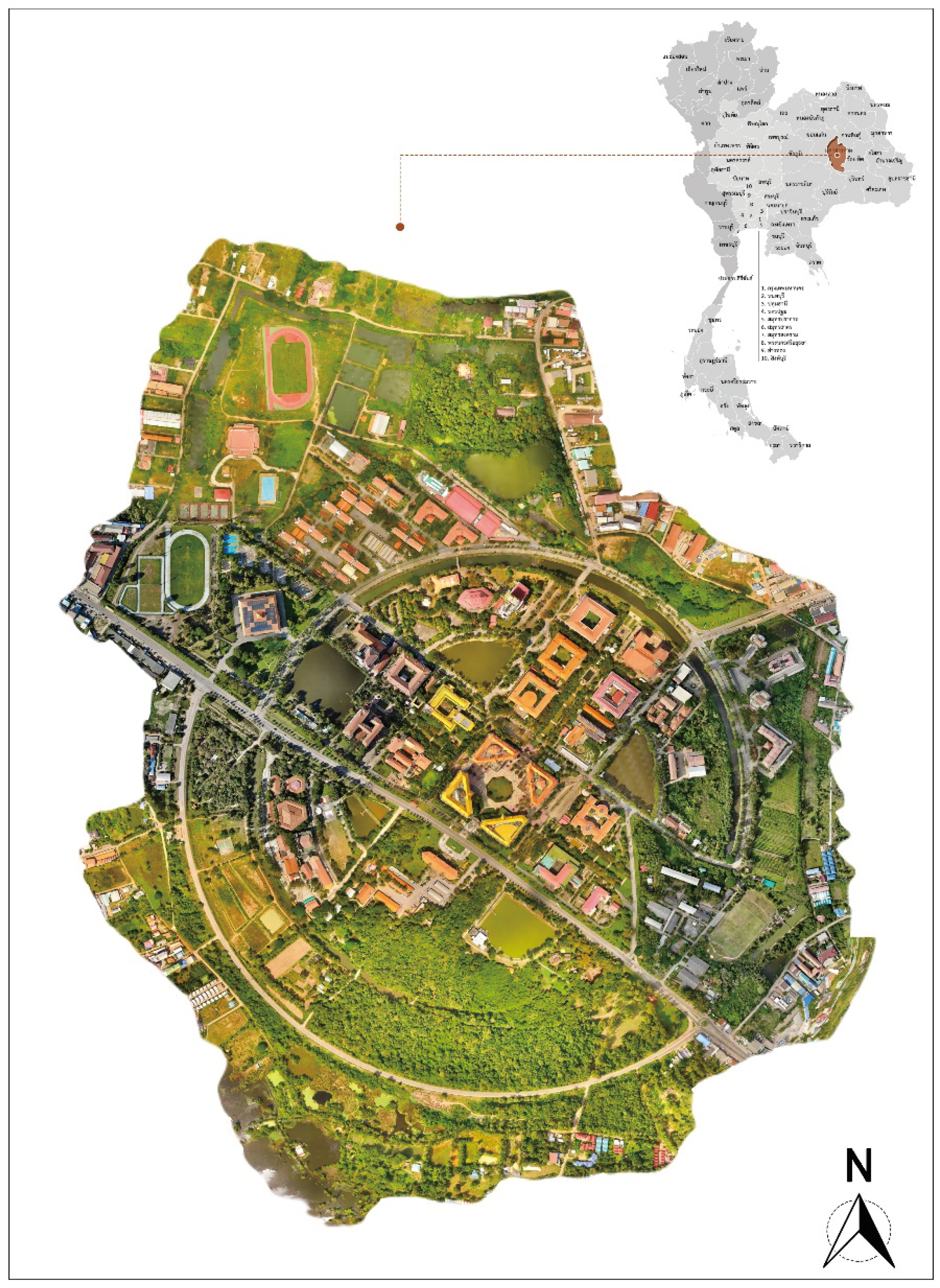
Figure 2.
Mahasarakham University, the Khamriang Campus.
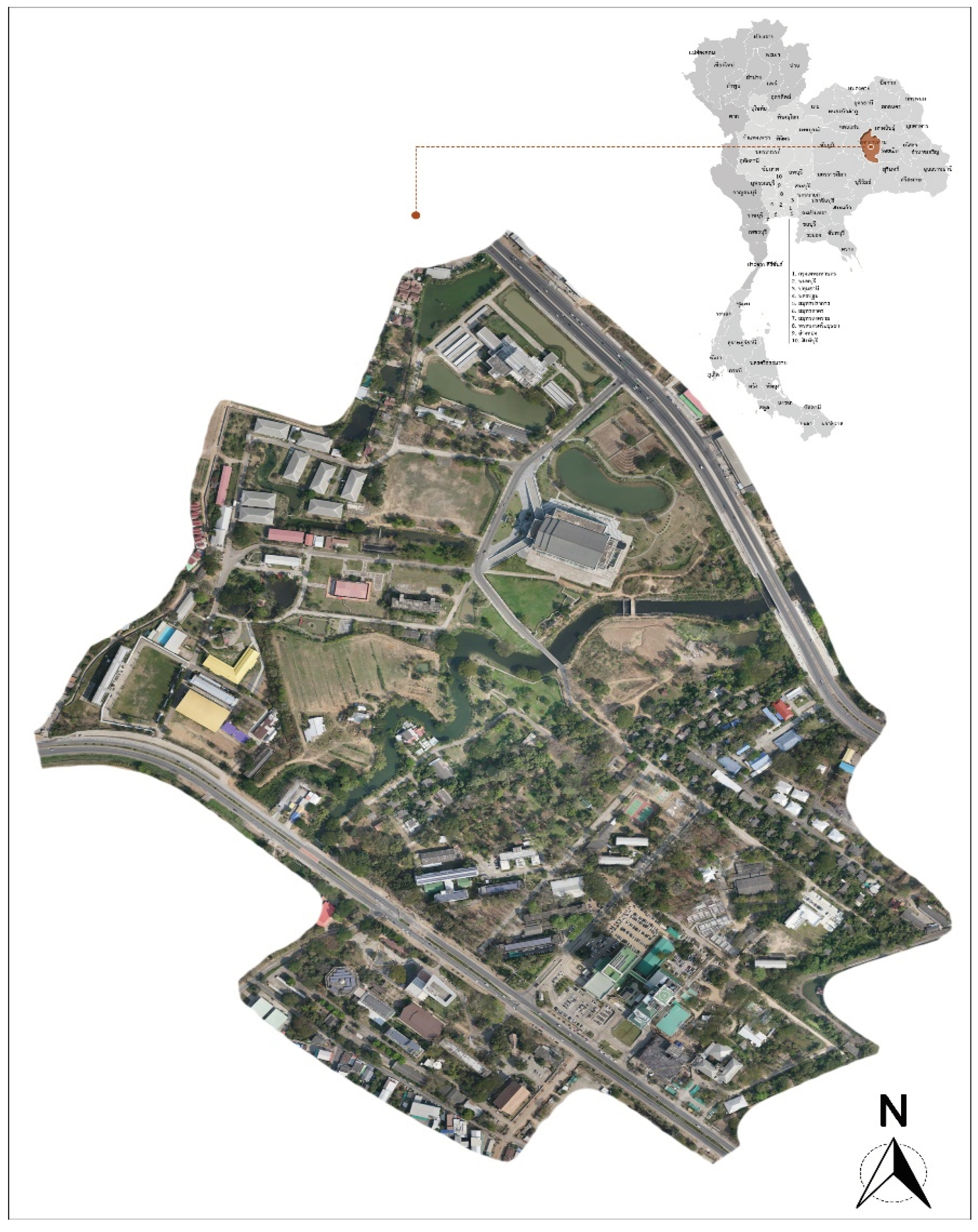
Figure 3.
The Waste management Ranking Results During 2019-2023.
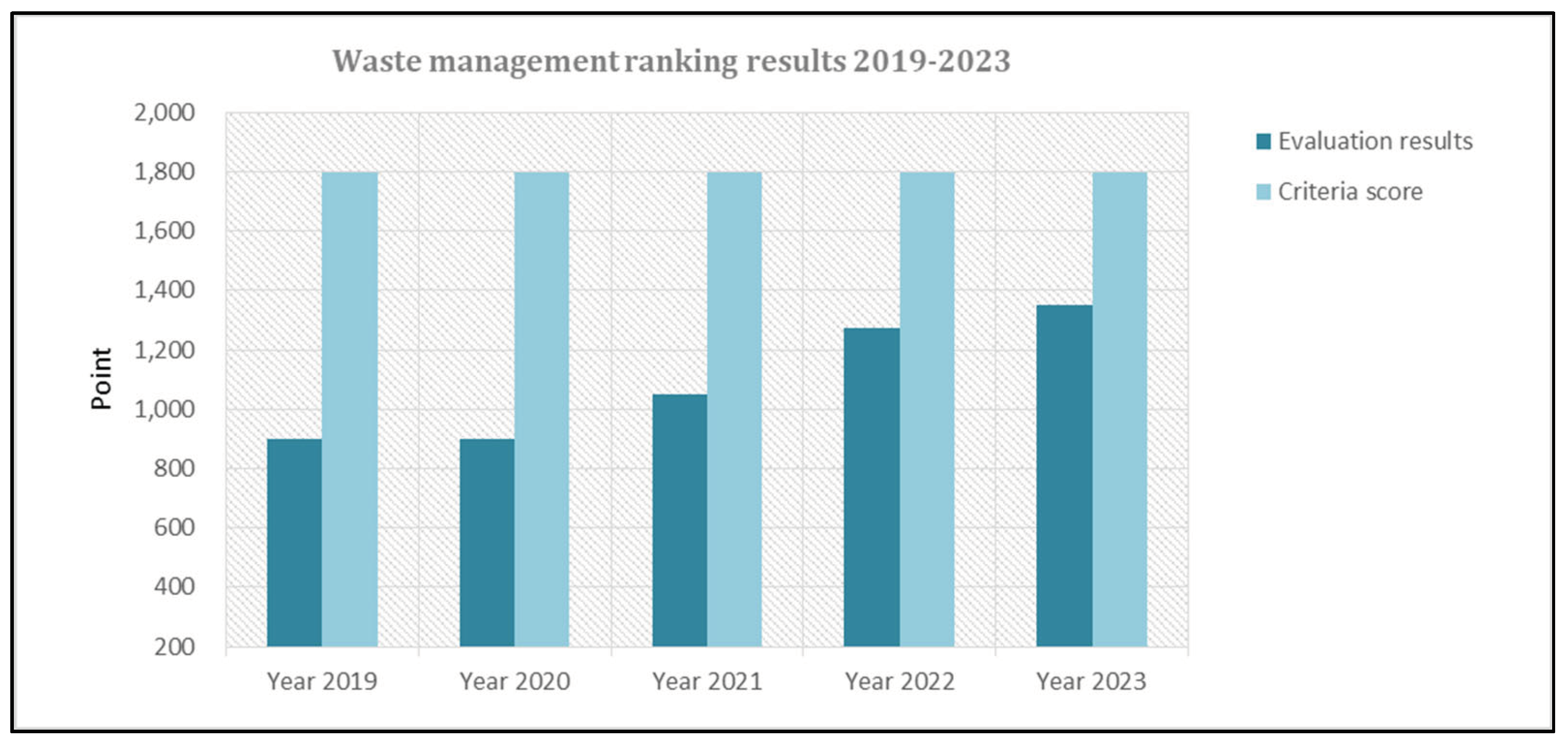
Figure 4.
Conducting the Projects and Evaluation Results.
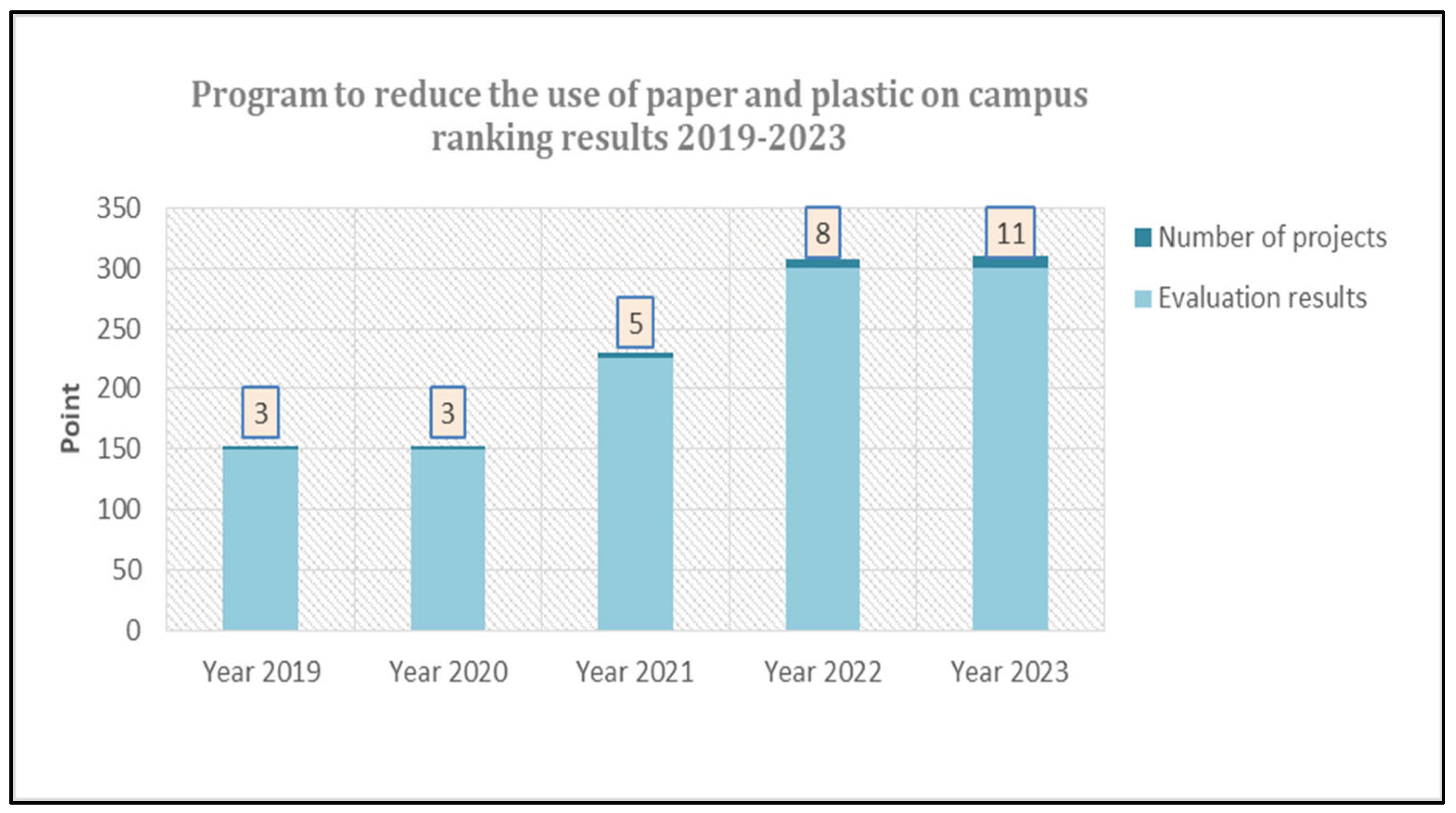
Figure 5.
The Garbage Collection Point.
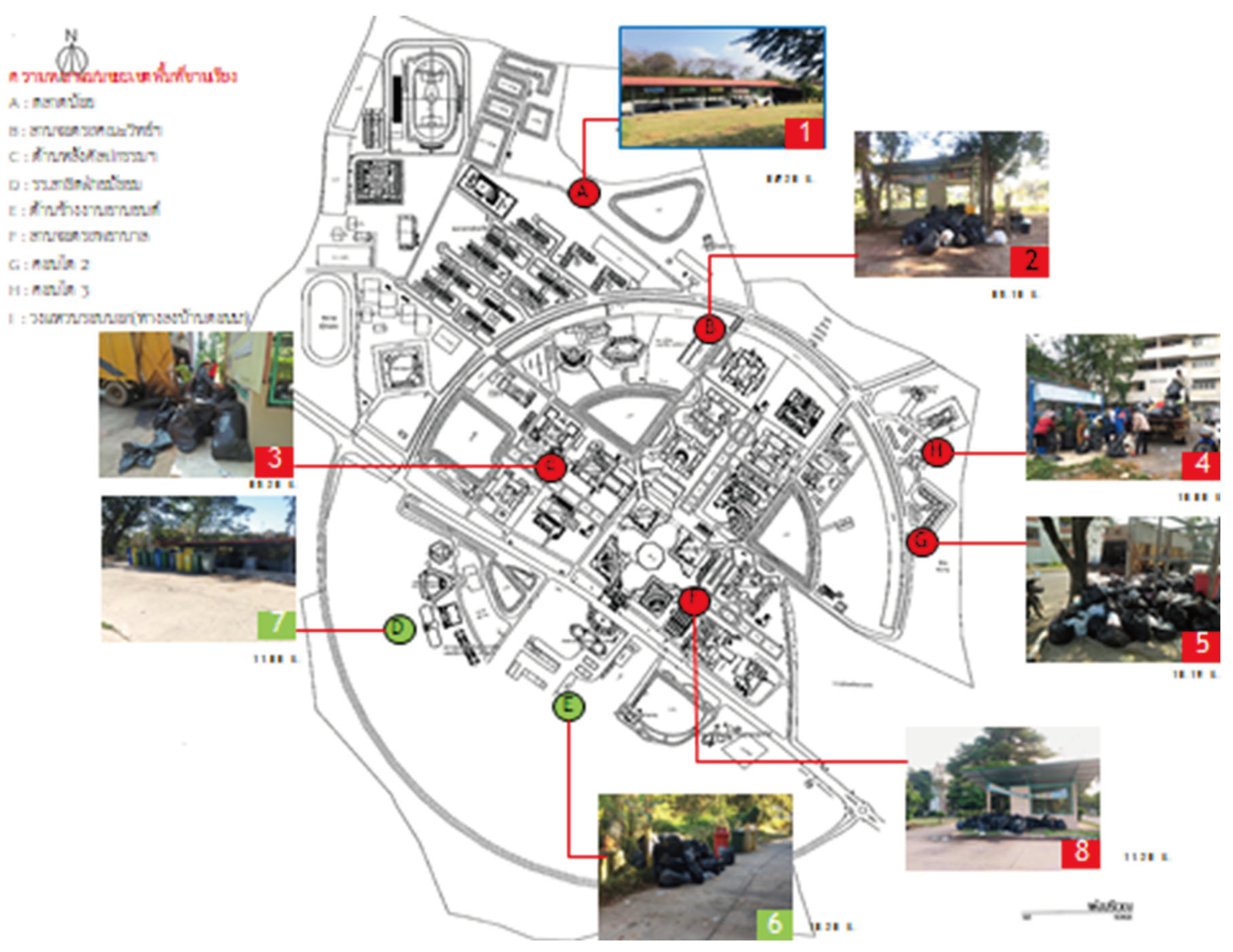
Figure 6.
The Sewage Treatment System of Mahasarakham University.
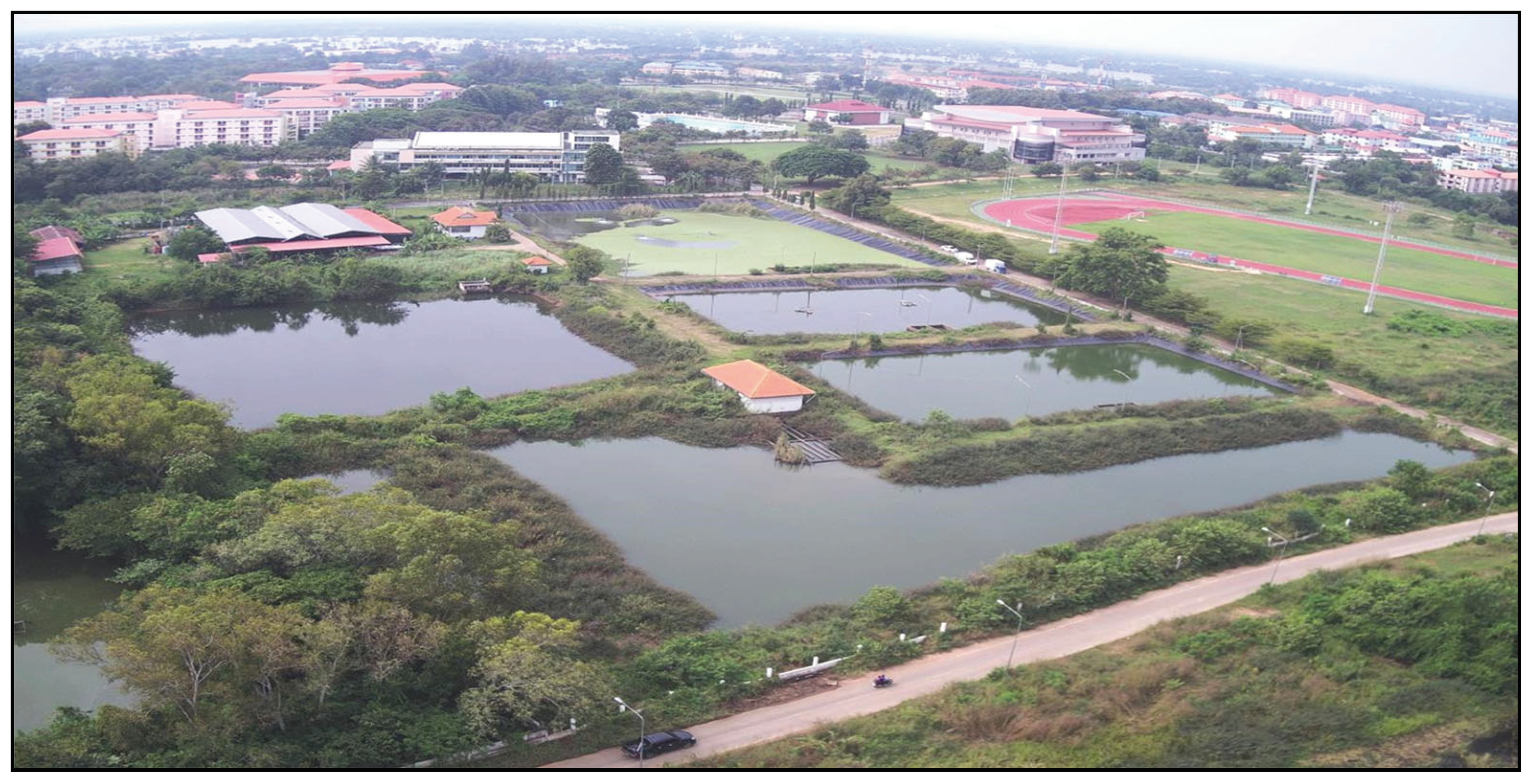
Figure 7.
The Diagram of the Wastewater Treatment Processes.
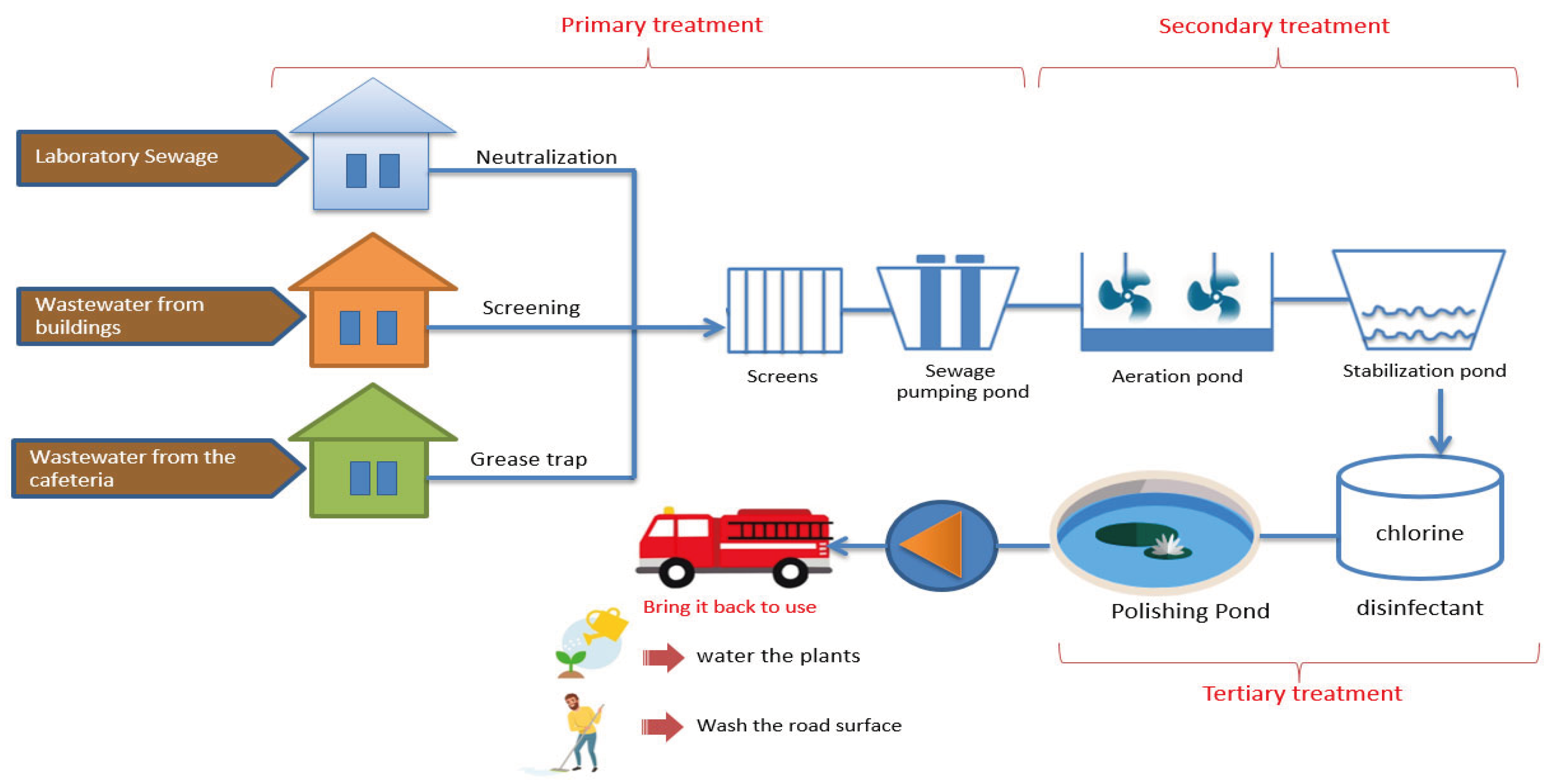
Figure 8.
The Daily Amounts of the Wastes of Mahasarakham University.
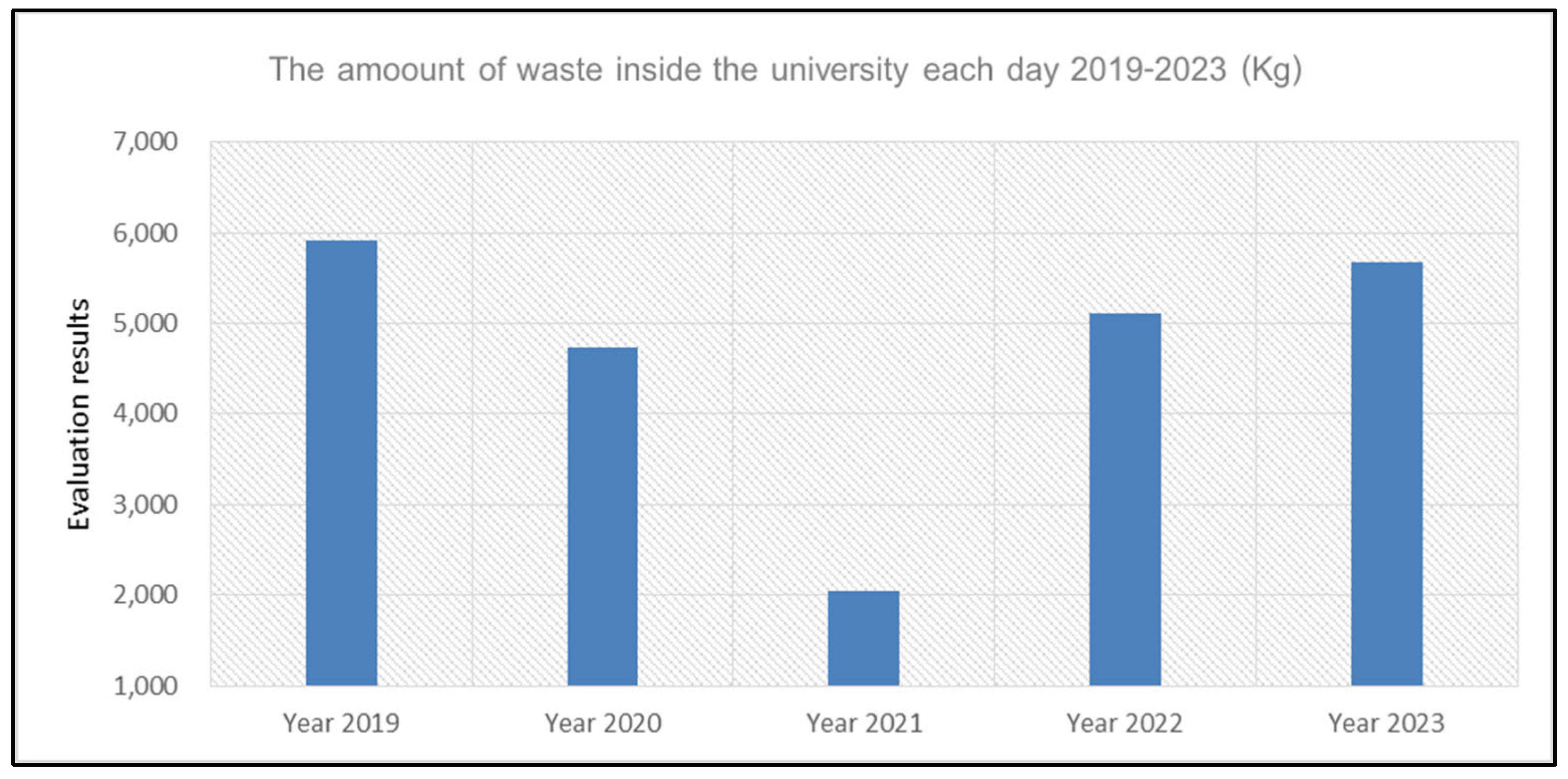
Figure 9.
The Amounts of the Daily Produced Wastes.
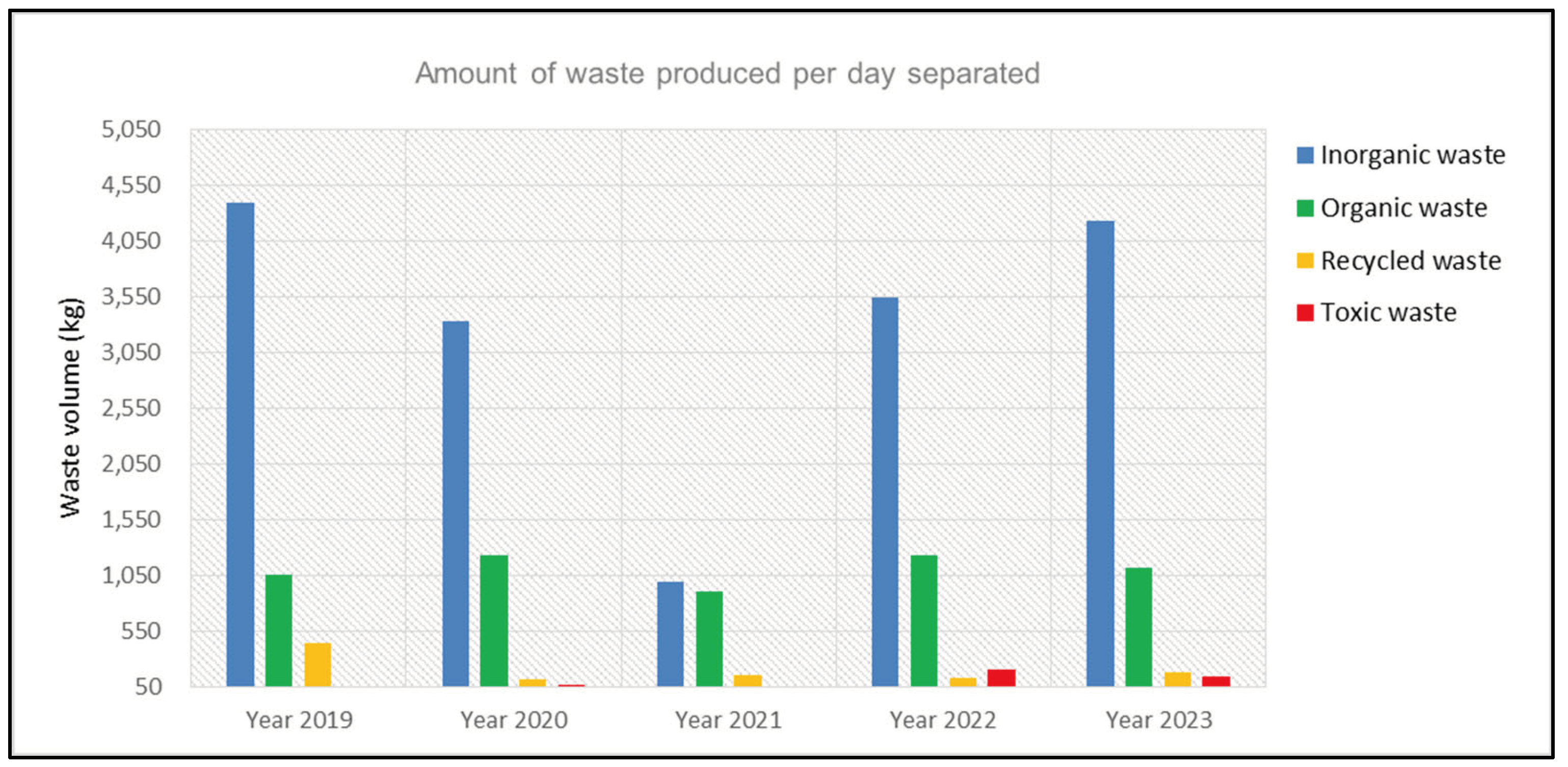
Figure 10.
The Evaluation Results of the Aspects of the Waste Management During 2019 – 2023.
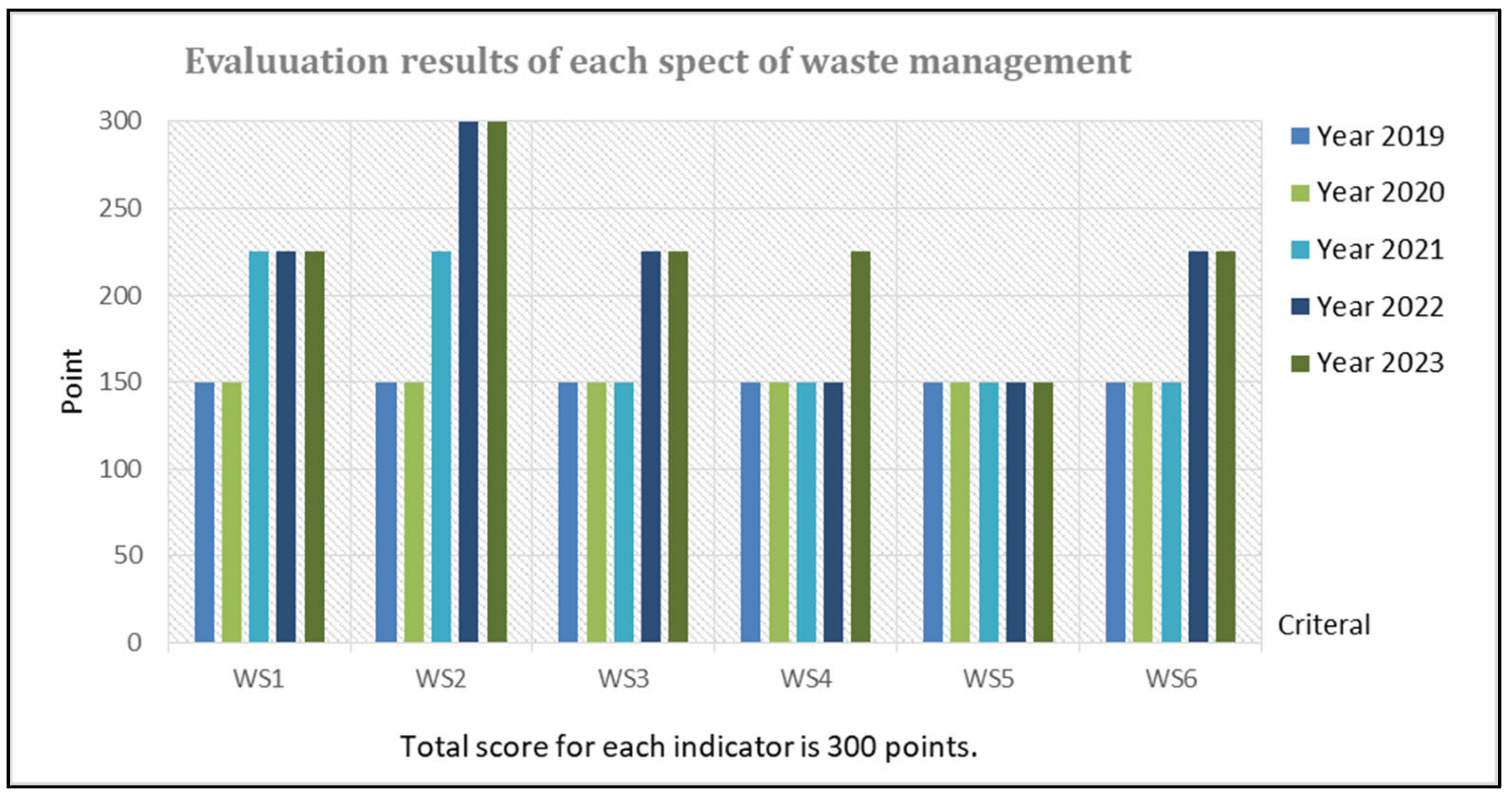
Figure 11.
World Rankings History Diagram.#
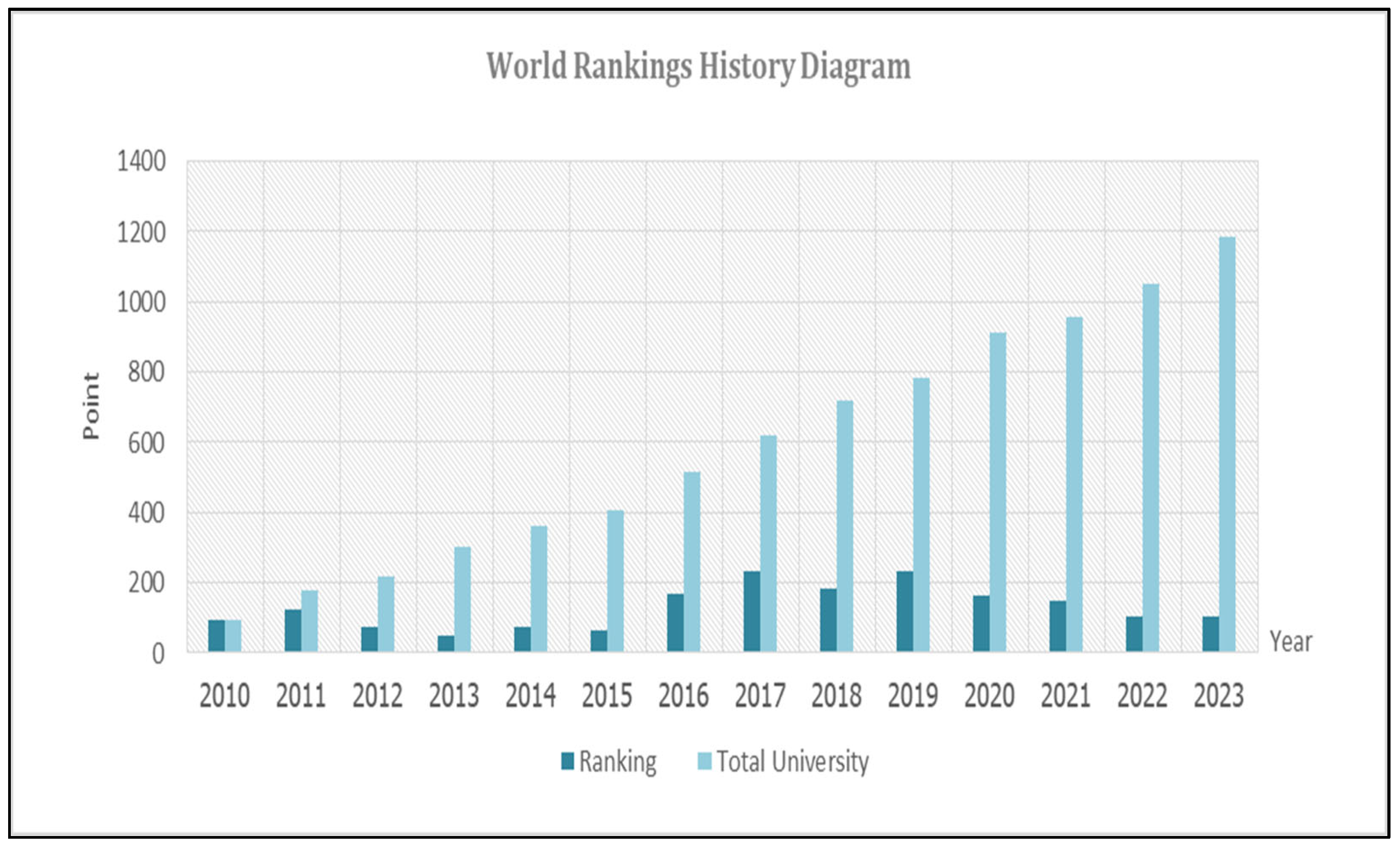
Figure 12.
World Rankings History Diagram (Scores).
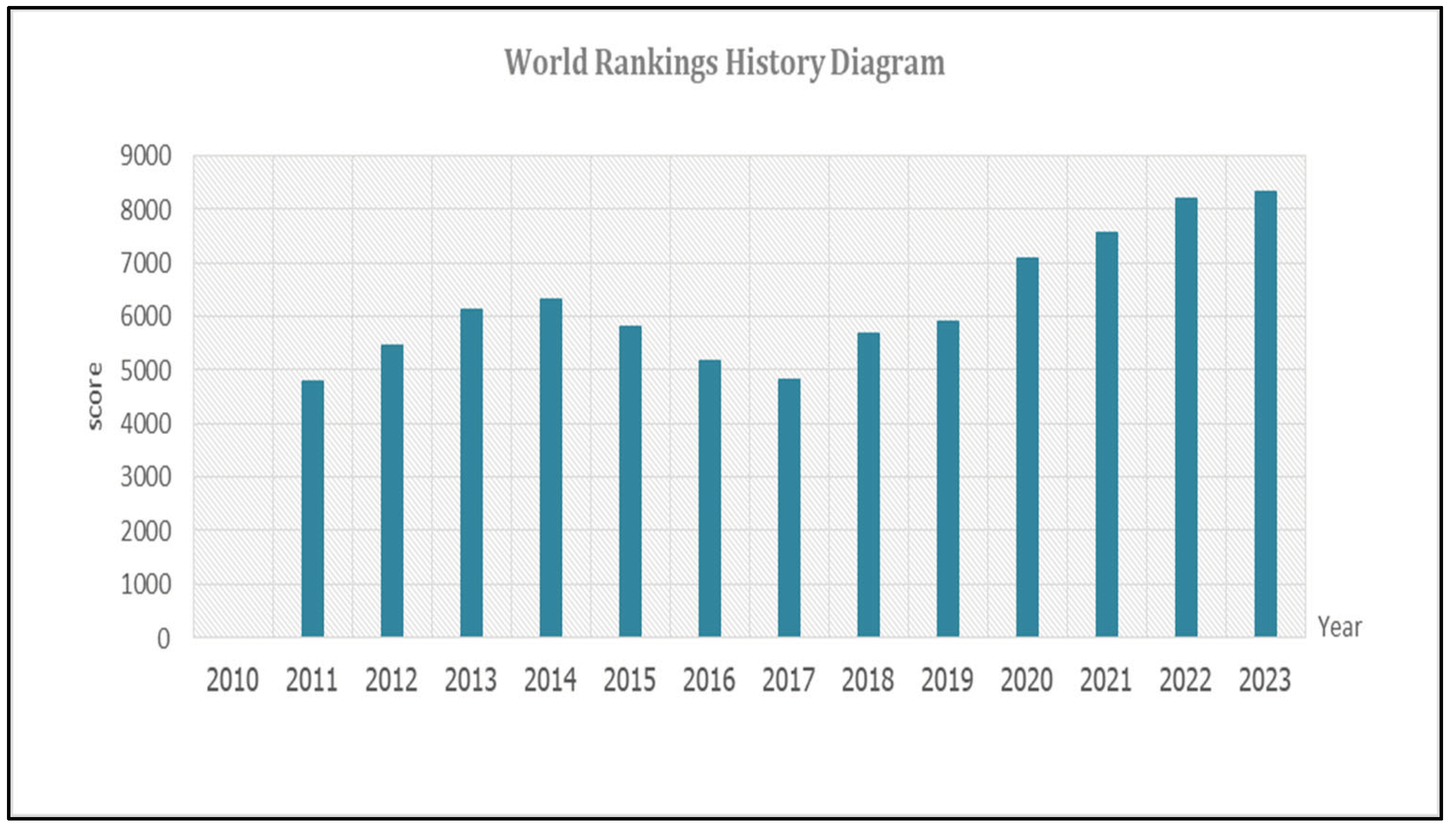
Table 1.
The Waste Management Evaluation Criteria During 2019 - 2023.
| No | CRITERIA | Point |
|---|---|---|
| WS1 | Recycling program for university's waste | 300 |
| WS2 | Program to reduce the use of paper and plastic on campus | 300 |
| WS3 | Organic waste treatment | 300 |
| WS4 | Inorganic waste treatment | 300 |
| WS5 | Toxic waste treatment | 300 |
| WS6 | Sewage disposal | 300 |
| Total (Weighting 18 %) | 1,800 |
Table 2.
The Results of the Waste Recycling Project During 2019 – 2023.
| Year | Score | Project Results | Project Details |
|---|---|---|---|
| 2019 | 150 | Project 1, 2 | 1. Waste sorting bins to create value 2. Organize a contest from recycled waste 3. Conduct “Recycle Waste Bank Project 4. Offer “Egg Exchange Waste Recycling Project” 5. Green Dormitory (Recycled garbage collects volunteer points) 6. Recycle waste to create inventions 7. Green University leaves a turn for the world to remember with GC YOU Turn. |
| 2020 | 150 | Project 1, 2, 3 | |
| 2021 | 225 | Project 1,4, 5 | |
| 2022 | 225 | Project 1,5,6 | |
| 2023 | 225 | Project 1,5,6, 7 |
Table 4.
The Summary of the Results of the Organic Waste Management Projects.
| Year | Score | Project results | Project details |
|---|---|---|---|
| 2019 | 150 | Project 1 | 1. Bio-fermented water production project (EM) 2. Compost production project 3. Vermicompost production project 4. Environmentally Friendly Fermentation Tank project 5. Pork Rice Bucket Project 6. Project to produce compost in beautiful gardens 7. Wood fuel production project (Charcoal) |
| 2020 | 150 | Project 1, 2, 3 | |
| 2022 | 150 | Project 1, 2, 3 | |
| 2022 | 225 | Project 2, 3, 4, 5 | |
| 2023 | 225 | Project 2, 3, 4, 5, 6,7 |
Table 5.
The Types of the Toxic Wastes in the University and the Management Guidelines.
| Toxic waste types | Management and treatment of toxic waste from laboratories |
|---|---|
| Toxic waste from laboratories | Including chemical waste, chemical containers The university provides special receptacles that can prevent leaks. Create a storage area separate from other types of waste. |
| Toxic waste from buildings | Including light bulbs, batteries, flashlight batteries. The university has set up disposal points or bins for hazardous waste separated from other types of waste with clear symbols. Then place them at various points and publicize it for students and personnel to know and practice. |
| Toxic waste from hospitals (Infectious waste) |
Waste that is contaminated with various secretions that can cause disease, such as syringes, surgical blades, gauze or cotton swabs that are contaminated with blood, etc. The university provides red containers to support and display them clearly symbolic. Then create a collection point separate from other types of waste and have a clear sign showing the storage location. |
Table 6.
The Results from Studying the Daily Amounts of the Wastes.
| Waste type | Volume (kg) | ||||
|---|---|---|---|---|---|
| Year 2019 | Year 2020 | Year 2021 | Year 2022 | Year 2023 | |
| Inorganic waste | 4,401 | 3,332 | 990 | 3,544 | 4,238 |
| Organic waste | 1,050 | 1,232 | 904 | 1,229 | 1,116 |
| Recycled waste | 444 | 121 | 158 | 131 | 174 |
| Toxic waste | 22 | 56 | 1 | 206 | 142 |
| Total | 5,917 | 4,741 | 2,053 | 5,109 | 5,670 |
Disclaimer/Publisher’s Note: The statements, opinions and data contained in all publications are solely those of the individual author(s) and contributor(s) and not of MDPI and/or the editor(s). MDPI and/or the editor(s) disclaim responsibility for any injury to people or property resulting from any ideas, methods, instructions or products referred to in the content. |
© 2024 by the authors. Licensee MDPI, Basel, Switzerland. This article is an open access article distributed under the terms and conditions of the Creative Commons Attribution (CC BY) license (http://creativecommons.org/licenses/by/4.0/).
Copyright: This open access article is published under a Creative Commons CC BY 4.0 license, which permit the free download, distribution, and reuse, provided that the author and preprint are cited in any reuse.
MDPI Initiatives
Important Links
© 2024 MDPI (Basel, Switzerland) unless otherwise stated




